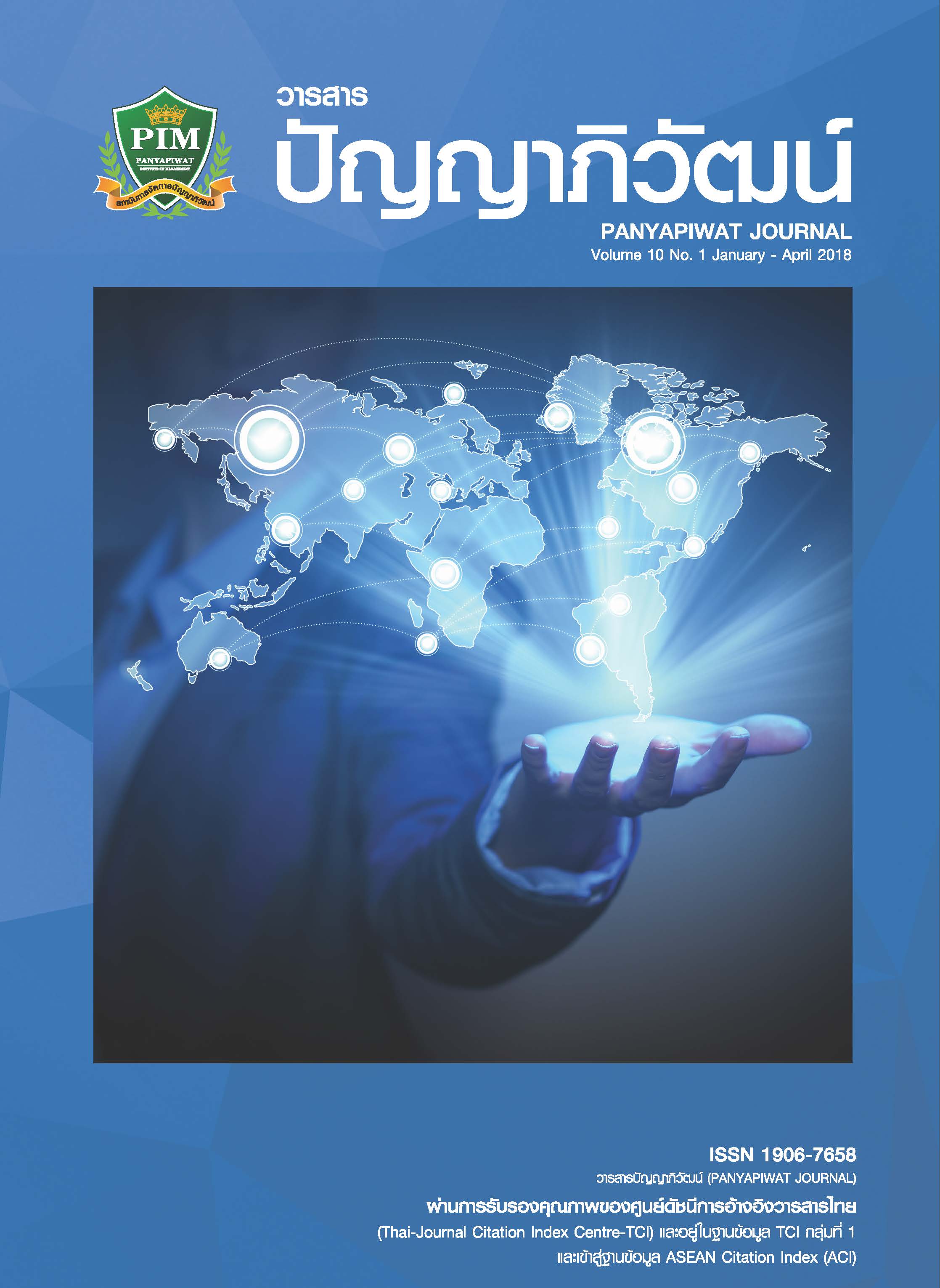การพัฒนารูปแบบการเรียนรู้ในกระบวนการพัฒนาผู้สืบทอดตำแหน่งของสถานประกอบการ
Main Article Content
บทคัดย่อ
การศึกษาวิจัยในครั้งนี้มีวัตถุประสงค์ 1) เพื่อพัฒนารูปแบบการเรียนรู้ในกระบวนการพัฒนาผู้สืบทอดตำแหน่งของสถานประกอบการ 2) เพื่อตรวจสอบและประเมินประสิทธิภาพของรูปแบบในกระบวนการพัฒนาผู้สืบทอดตำแหน่งของสถานประกอบการ โดยใช้กระบวนการวิจัยและพัฒนา เครื่องมือวิจัยได้แก่ การสัมภาษณ์เชิงลึก การสนทนากลุ่ม และแบบประเมินประสิทธิภาพ กลุ่มผู้ให้ข้อมูลคือ ผู้บริหารระดับนโยบายจากสถานประกอบการที่ได้รับรางวัลด้านการบริหารความเป็นเลิศด้านการจัดการทรัพยากรบุคคล และนักพัฒนาทรัพยากรมนุษย์ที่มีหน้าที่บริหารจัดการการพัฒนาผู้สืบทอดตำแหน่ง
ผลการวิจัยพบว่า กระบวนการพัฒนาผู้สืบทอดตำแหน่ง ประกอบไปด้วย 5 ขั้นตอน ได้แก่ 1) กำหนดเป้าประสงค์หรือจุดมุ่งหมายเพื่อการพัฒนา 2) การประเมินความต้องการจำเป็นในการพัฒนา 3) การจัดทำแผนพัฒนารายบุคคล 4) ดำเนินการตามแผนการพัฒนา 5) การประเมินผลการพัฒนาและผลลัพธ์ และประกอบไปด้วย 5 องค์ประกอบหลัก ได้แก่ 1) ปัจจัยแห่งความสำเร็จของบริหารจัดการการพัฒนาผู้สืบทอดตำแหน่ง 2) รูปแบบการเรียนรู้ 3) การเรียนรู้จากการปฏิบัติ 4) สภาพแวดล้อมที่ส่งเสริมการถ่ายโอนความรู้ 5) ตัวชี้วัดการพัฒนาผู้สืบทอดตำแหน่ง ผลการประเมินประสิทธิภาพของรูปแบบ ด้านความเหมาะสม ด้านความถูกต้องครอบคลุม ด้านความเป็นไปได้ และด้านความเป็นประโยชน์ พบว่า ประสิทธิภาพของรูปแบบการเรียนรู้ในสถานประกอบการเพื่อพัฒนาผู้สืบทอดตำแหน่งโดยรวมและรายด้านอยู่ในระดับมากถึงมากที่สุด
The purposes of this research were as follows: 1) to develop a learning model for the successor development process of the establishment; 2) to examine and evaluate the efficiency of the learning model for the successor development process of the establishment. This is research and development research and the research instruments included in-depth interviews, focus group discussions and an efficacy questionnaire for learning model.
The results of this research were carried out via in-depth interviews with the sample group were comprised of top human resources executives from companies that received human resource excellence awards and held focus group meetings with professionals from the organizations that targeted successor development. The results of the qualitative research revealed that there were five steps of successor development process, as follows: 1) set goals or objectives for development; 2) assess the needs for development; 3) prepare an individual development plan; 4) implementing development plans; 5) evaluation of development results. Furthermore, there were five components in the new frame of reference including; 1) success factors of management and succession development; 2) learning styles; 3) action learning; 4) support a workplace learning environment; and 5) measure succession development. The quantitative analysis measured the efficacy questionnaire for the learning model results of the sample group, revealing that the learning model proved to be at the highest levels in terms of appropriateness, correctness, possibility and the usefulness of the learning model for successor development process of the establishment.
Article Details
“ข้าพเจ้าและผู้เขียนร่วม (ถ้ามี) ขอรับรองว่า บทความที่เสนอมานี้ยังไม่เคยได้รับการตีพิมพ์และไม่ได้อยู่ระหว่างกระบวนการพิจารณาลงตีพิมพ์ในวารสารหรือแหล่งเผยแพร่อื่นใด ข้าพเจ้าและผู้เขียนร่วมยอมรับหลักเกณฑ์การพิจารณาต้นฉบับ ทั้งยินยอมให้กองบรรณาธิการมีสิทธิ์พิจารณาและตรวจแก้ต้นฉบับได้ตามที่เห็นสมควร พร้อมนี้ขอมอบลิขสิทธิ์บทความที่ได้รับการตีพิมพ์ให้แก่สถาบันการจัดการปัญญาภิวัฒน์หากมีการฟ้องร้องเรื่องการละเมิดลิขสิทธิ์เกี่ยวกับภาพ กราฟ ข้อความส่วนใดส่วนหนึ่งและ/หรือข้อคิดเห็นที่ปรากฏในบทความข้าพเจ้าและผู้เขียนร่วมยินยอมรับผิดชอบแต่เพียงฝ่ายเดียว”
เอกสารอ้างอิง
Action Learning Model. (2002). Action Learning Model. Retrieved April 10, 2017, from https://school.unitecnology.ac.nz/action_learning.html
Aon Hewitt. (2013). Building the Right High Potential Pool. How Organizations Define, Assess, and Calibrate Their Critical Talent. Retrieved December 15, 2016, from https://www.aon.com/ attachments/human-capital consulting/2013_Building_the_Right_High_Potential_Pool white_paper.pdf
Chalachol, S. (2016). The Important of Environment Effecting Transfer of Training. Journal of Marketing and Management Rajamangala University of Technology Thanyaburi, 3(1), 13-25. [in Thai]
Deloitte Touche Tohmatsu Limited. (2017). Rewriting the rules for the digital age: 2017 Deloitte Global Human Capital Trends. Deloitte University Press, 19-22.
Frankena, W. K (1976). The philosophy of vocation. Thought: Fordham University Quarterly, 51(4), 393-408.
Hoffman, T. & Womack, S. (2011). Succession planning: What is the cost of doing it poorly or not at all? New York PricewaterhouseCoopers.
Nergard, T. (2002). Action learning: Some principles and practicalities. Bangkok: Civil Service Training Institute.
Klingk, M., Gielen, E. & Nauta, C. (2001). Supervisory Support as a major Condition to Enhance Transfer. International Journal of Training and Development, 5(1), 52-63.
Kolb, D. A. (1984). Experiential Learning: Experience as the source of Learning and Development. New Jersey: Prentice Hall.
Northeast Leadership Academy. (2016). Talent Management Potential Ratings. London: The NHS North East Leadership Academy.
Pimolsaengsuriya, A. (2010). Why Succession Planning Typically Fall. Retrieved December 15, 2016, from https://slingshot.co.th//resources/library/SuccessionPlanningทำไมจึงไม่สำเร็จ /1107 [in Thai]
Rothwell, W. J. (2002). Putting Success into Your Succession Planning. Journal of Business Strategy, 23(3), 32-37.
Rothwell, W. J. (2010). Effective succession planning: Ensuring leadership continuity and building talent from within (4th ed.). New York: American Management Association.
Ruangaram, N. (2011). The Development of Nojomtien Community Learning Center Model. Dissertation, Doctor of Philosophy Program in Education Technology, Burapha University. [in Thail]
Suriyakral, S. (2011). Learning Styles of Pharmacy Students: Theory and Finding. Isan Joumal of Pharmaceutical Sciences, 7(1), 1-10. [in Thai]
Tonsil, P. V. (2010). Human Capital Management Succession Planning in the Federal Acquisition Workforce. Journal of Contract Management, (Summer 2010), 23-28.
Towers Watson. (2010). Five Rules for Talent Management in the New Economy. New York Towers Watson.
Vanicharoenchai, V. (2010). Action Learning Applications for Teaching and Learning. Journal of Nursing Sciences Faculty of Nursing Mahidol University, 28(4), 36-44. (in Thai]


